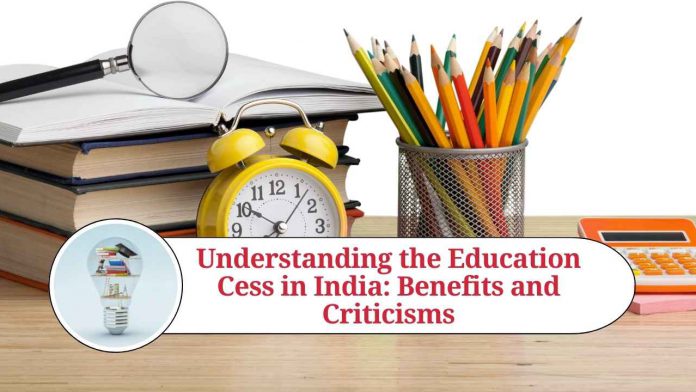Understanding the Education Cess: What it is and How it Works
In India, the education sector is a key priority for the government. However, given the limited resources available to the government, it is not always possible to allocate sufficient funds for education. This is where the education cess comes into play. In this blog, we will explore what the education cess is, how it works, and its impact on education in India.
What is Education Cess?
Education cess is an additional tax levied on individuals and businesses to fund education initiatives in India. The government first introduced the education cess in 2004 as part of the Education Cess Act. The cess is a form of surcharge on the total tax payable, and the revenue generated from it is used exclusively for educational purposes.
How Does it Work?
The education cess is calculated as a percentage of the total tax payable. Currently, the education cess is set at 4% of the total tax payable. This means that if an individual or business owes Rs. 10,000 in taxes, they will be required to pay an additional Rs. 400 as education cess.
The revenue generated from the education cess is collected by the government and deposited into the Consolidated Fund of India. This fund is then used to finance various education initiatives, including the Sarva Shiksha Abhiyan (SSA), Rashtriya Madhyamik Shiksha Abhiyan (RMSA), and Mid-day Meal Scheme.
Impact on Education in India
The education cess has had a significant impact on education in India. Since its introduction, the government has been able to increase spending on education and improve access to education for children across the country.
One of the most significant initiatives that have been funded by the education cess is the SSA. This initiative aims to provide free and compulsory education to all children between the ages of 6 and 14. The SSA has been instrumental in increasing enrollment rates and improving the quality of education in government schools.
The education cess has also helped fund the RMSA, which aims to improve access to secondary education in India. The RMSA has helped build new schools, upgrade existing schools, and provide vocational training to students.
Benefits and Criticisms of Education Cess
While the education cess has been instrumental in improving access to education in India, it has also faced criticism from some quarters. In this section, we will explore the benefits and criticisms of the education cess.
Benefits of Education Cess
- Increased funding for education: The education cess has helped increase funding for education initiatives in India. The additional revenue generated from the cess has been used to build new schools, upgrade existing schools, and provide vocational training to students.
- Improved access to education: The education cess has helped improve access to education for children across the country. Initiatives such as the SSA and the RMSA have helped increase enrollment rates and improve the quality of education in government schools.
- Targeted funding: The education cess is a targeted form of taxation, with the revenue generated used exclusively for educational purposes. This ensures that the funds are used effectively and efficiently, with a clear focus on improving education in India.
Criticisms of Education Cess
- Burden on taxpayers: Critics of the education cess argue that it places an unnecessary burden on taxpayers. While the tax is only a small percentage of the total tax payable, it can add up over time and place a significant burden on low-income individuals and businesses.
- Lack of transparency: Some critics argue that there is a lack of transparency in how the revenue generated from the education cess is used. While the funds are supposed to be used exclusively for education initiatives, there have been instances where the funds have been diverted for other purposes.
- Insufficient funding: While the education cess has helped increase funding for education in India, some argue that it is not enough. India still lags behind many other countries in terms of education spending, and more needs to be done to improve the quality of education in the country.
Conclusion
In conclusion, the education cess is a targeted form of taxation that has helped increase funding for education initiatives in India. While it has faced criticism from some quarters, it has played an important role in improving access to education for children across the country. Moving forward, it is important to ensure that the revenue generated from the education cess is used effectively and efficiently, with a clear focus on improving the quality of education in India.
Read more useful content:
Frequently Asked Questions (FAQs)
- What is the education cess in India?
The education cess is an additional tax levied on individuals and businesses to fund education initiatives in India. It was introduced in 2004 as part of the Education Cess Act and is currently set at 4% of the total tax payable.
- How is the education cess calculated?
The education cess is calculated as a percentage of the total tax payable. Currently, it is set at 4% of the total tax payable.
- What is the revenue generated from the education cess used for?
The revenue generated from the education cess is used exclusively for education initiatives in India. It is deposited into the Consolidated Fund of India and is used to finance various education initiatives, including the Sarva Shiksha Abhiyan (SSA), Rashtriya Madhyamik Shiksha Abhiyan (RMSA), and Mid-day Meal Scheme.
- Is the education cess applicable to all taxpayers in India?
Yes, the education cess is applicable to all taxpayers in India. It is levied on individuals and businesses as a surcharge on the total tax payable.
- How has the education cess impacted education in India?
The education cess has had a significant impact on education in India. Since its introduction, the government has been able to increase spending on education and improve access to education for children across the country.
- Can the revenue generated from the education cess be used for other purposes?
No, the revenue generated from the education cess is supposed to be used exclusively for education initiatives in India. However, there have been instances where the funds have been diverted for other purposes.
- Is the education cess a permanent tax?
There is no indication that the education cess is a permanent tax. It is reviewed periodically by the government and can be revised or discontinued as needed.
- Are there any exemptions to the education cess?
No, there are no exemptions to the education cess. It is applicable to all taxpayers in India.
- Can the education cess be paid separately from other taxes?
No, the education cess cannot be paid separately from other taxes. It is calculated as a percentage of the total tax payable and is included in the overall tax bill.
- How can individuals and businesses ensure that the revenue generated from the education cess is used effectively?
Individuals and businesses can monitor the government’s spending on education initiatives to ensure that the revenue generated from the education cess is used effectively. They can also participate in local education initiatives and support organizations that work towards improving education in India.




















